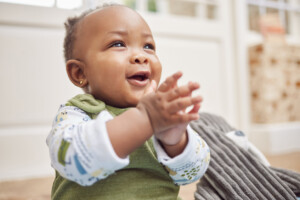Pacifiers and breastfeeding, yes or no? If you are a breastfeeding mom, I am sure this question has crossed your mind. Pacifiers have become the norm in Western societies.1 They even have multiple nicknames they go by, like paci, binky, dummy, nini, or soothie.
Although it is common to see an infant or toddler with a pacifier in their mouth, there are several pros and cons to consider when introducing your little one to a pacifier. Let’s help you make your decision a little easier by diving into everything you should know about pacifiers and breastfeeding.
Can I Give My Baby a Pacifier If They Are Breastfeeding?
The short answer is yes, you can use pacifiers when breastfeeding, but let’s break this down. The American Academy of Pediatrics (AAP) released new guidance earlier this year for breastfeeding for the first time in a decade. In this new release, they continue to suggest that pacifier use be a personal decision made by the parent.2 You read that right. Research has shown that offering a pacifier to a healthy infant shows no significant impact on the duration of breastfeeding when offered before or after the breastfeeding relationship is established up to 4 months.3 Phew; you can relax now, mama.
Pros and Cons of Introducing a Pacifier
Now, let’s talk about the benefits and concerns of pacifier use.
Pros of Using a Pacifier
1. It decreases the Risk of Sudden Infant Death Syndrome (SIDS)
The AAP guidance for safe sleep includes using a pacifier consistently to lower the risk of SIDS. Although the reason why pacifier use reduces the risk has not been determined, studies have shown a favorable relationship between pacifier use and decreased risk of SIDS. It is essential to offer the pacifier during all sleeping periods, both nap times and bedtime. The AAP notes that if the pacifier falls out while the baby is sleeping, there is no need to put it back in, and if your baby does not like a pacifier, do not force them to use one.4
2. It’s Soothing for Babies
Newborns have a natural sucking reflex. Nonnutritive sucking can be soothing for your baby.1 It can even promote feelings of security for your little one.5
3. It Can Be a Pain Reliever
Unfortunately, some babies will have to undergo common procedures such as heel sticks, venipunctures, circumcisions, or immunizations that may cause pain. It has been found that using a pacifier for babies under six months can have analgesic, pain-relieving effects.1
Cons of Using a Pacifier
1. Dental Concerns
When it comes to “longer-term” pacifier use, dental concerns can be at the forefront of problems. The American Academy of Pediatric Dentistry (AAPD) expresses concerns about pacifier use after 36 months. When a pacifier is used for extended periods, the risk of your child developing oral and dental problems, such as malocclusion, anterior open bites, and posterior cross-bites, increases.5
2. Otitis Media (Ear Infections)
Pacifier use can increase your child’s risk of developing an ear infection, especially recurrent ear infections.6 It has been recommended to stop pacifier use after six months to decrease the risk of developing otitis media.1
3. Infections
Pacifiers can harbor yucky germs that could make your little one sick. Germs could cause gastrointestinal and respiratory infections. Ensure your little one’s pacifier is clean before each use to help decrease germ exposure.1
4. Possible Impact on Milk Supply
As we know, babies love to suck. If they are given a pacifier when hungry, causing them to miss a meal, this could impact your milk supply. Breastmilk production is based on demand, so if your baby feeds less, you may start producing less milk. It is essential only to give your baby a pacifier when you know they are not hungry to help combat this potential problem.3
Tips for Introducing and Using a Pacifier
There are many brands of pacifiers. There are different bases, different nipple shapes, different weights, and the list goes on. Is one pacifier better than another? With time, you will find the one your baby likes best. When looking for a pacifier, the AAP recommends you find one large enough not to fit completely in your child’s mouth. You also want to ensure it has a firm shield and vent holes and is one single piece, making it harder to break into small pieces your baby could choke on.5
Once you find the pacifier your baby likes, here are a few tips:
- Make sure you clean the pacifier before using it each time. This will help decrease the germs your baby is exposed to.
- Don’t force your baby to use a pacifier. Some babies love pacifiers; some want nothing to do with them.
- Only offer the pacifier when you know your baby is not hungry.3
- Never tie a pacifier around your baby’s neck.
- Inspect the pacifier before each use. Look for any structural damage or wear that could increase your baby’s risk of choking.5
Pacifiers for Breastfed Babies
If you have chosen to introduce a pacifier to your baby, here are the best pacifiers for breastfeeding babies.









































